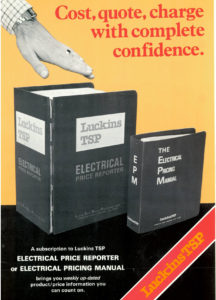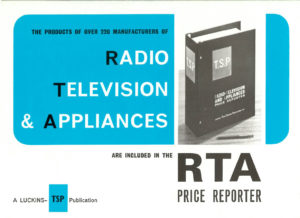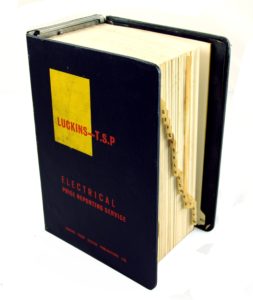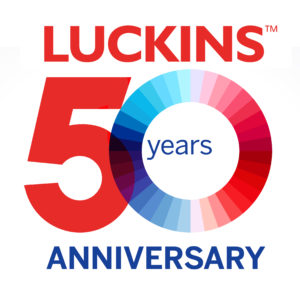The price is right! Luckins celebrates 50 years
The year 1966 will be remembered by many as the year that we lifted the World Cup. But 1966 also has huge significance for electrical wholesalers – it was the year that Luckins was launched. The ‘industry bible’ has become the must-have reference point on trade prices for busy wholesalers and contractors. Fifty years on, Editor, Debbie Eales, meets the company’s Content Director, Richard Appleton, to learn about Luckins’ colourful history.
Not a lot has fazed Luckins over the years… take-overs, postal strikes, the three day week, decimalisation and rampant inflation have all had their part to play in the company’s history and tested its ingenuity and efficiency to the nth degree. But throughout, Luckins has always delivered.
Luckins’ name runs through the industry like a stick of Brighton rock. The indispensable pricing guide has had many twists and turns – starting as a relatively low-tech, lick and stick price reporter in the days before computerisation.
Content Director, Richard Appleton explains: “Originally, the pricing data was provided in the form or large loose leaf books. We’d gather the information and update pages, so the wholesaler would receive a pack of replacement pages each week.
“We started well before we had computers. Manufacturers would send us price lists and that data was compiled onto the pages of a book by typing them on bits of paper, sticking them on with cow gum and creating printing plates from that. Looking at some of the early books, you can tell they were printed from pages that had been typed and sometimes, things are a bit wobbly.”

In the first few years, a number of challenges occurred. Continues Richard: “Between 1966 and the mid-’70s, there was massive inflation, peaking at 24%, so prices were changing all the time and it was almost impossible to keep up.
“Then we had decimalisation – I believe we produced prices in pounds, shillings and pence and in the ‘new money’. Effectively, two sets of pages were published.
“Then there were postal strikes. With inflation and masses of price changes, how were we going to get the price lists to the wholesalers?
“The people who were usually typing up the lists and sticking them down with cow gum would have to take boxes of updates in envelopes then drive to a friendly wholesaler who would act as a drop off point, then customers would drive in to pick up their updates.”
Such service was much appreciated by Luckins’ customers and the company became very much a part of the industry.
Says Richard: “The Luckins book was like an industry Bible and every wholesaler had one on the counter. Behind the scenes, there was probably another one being used for invoicing.”
Product range
Since 1966, the range of electrical products has grown enormously. Says Richard: “In the first price reports, there were probably 50,000 products. Today’s database contains 1.4 million. The scope has also broadened. Once, there were just 10 manufacturers of wiring accessories – now there are 50.”
The technological revolution has seen a raft of additions, from IT and data networking components to renewables, security, access control and more.

“There are things that have gone, as well,” continues Richard. “In the mid-’60s, we had a parallel book for radio and television accessories. In those days, wholesalers would cover domestic electronic products, before the days of Currys.
“But while the scope is massively different, the way we operate has been fairly constant. The use of a trade price system is something that wholesalers value.”
These days, most of the data is in electronic form. Richard explains: “The first electronic data was sent out in 1975 but obviously, on a very small scale. It used to be on magnetic tape or punch cards. These days it is done by FTP (file transfer protocol) or via email. And the data is integrated into the customers’ systems now. In the past, in book form, the data was there to be referred to. Today, it’s fed right into the heart of wholesalers’ ERP systems.
“It’s on a computer, literally at the heart of their system. But the person on the trade counter probably doesn’t know that. And this is one of the challenges we face, because we have become a bit invisible. Whereas at one point there was a book on every trade counter.”
So how did it all begin?
The business model for Luckins sprang from a meeting in the mid-’60s between members of the Electrical Wholesalers’ Federation (forerunner of the EDA) with their opposite numbers in the United States.
Says Richard: “While there, they saw the big loose leaf price reporters which were published by Trade Service – and they thought ‘what a great idea; wouldn’t it be good if we could have something like that in the UK’.
With a commitment by a number of wholesalers to buy the price reporters, a company was formed by two directors of Trade Service and Luckins, a publisher/printer in Stamford, and they began compiling trade price data around a dining room table!

Positive move
Luckins was an independent company until 2008 when it was acquired by the Amtech group – a software provider to electrical and, to some extent, mechanical engineers and contractors.
“That was very positive for us,” recalls Richard. “It enabled us to work as we need to, as the content relied much more heavily on the software side of the business.”
In 2014, Amtech was acquired by Trimble – a large, US-based software company that operates in a number of sectors, including construction.
“This, again, was clearly a very positive move,” says Richard. “They bought the business in the UK, wanting to grow it. We are specifically part of Trimble MEP – Mechanical Electrical Plumbing.
“Prior to buying Amtech, Trimble had also acquired Trade Service Corporation, based in San Diego, and Trade Service essentially do the same as Luckins, and in fact, back in the dim and distant past when we started, the original directors of Trade Service also had a share in the Luckins business.
“The two had parted ways, as time had gone on, and now we’re all back together again. So we’re building ourselves up now as one global content business.”
Continues Richard: “We are unique in the UK. There are others who do bits of what we do. But I don’t think there is anyone providing what we do both to the distributors and to the contractors. The great benefit of that is that they are getting synchronised content.”
I asked Richard what Luckins has brought to the industry? “It has brought consistency,” he says, “and what is essential about it is enabling wholesalers and the contractors to do what they do best, which is buying and selling electrical goods and installing them.
“We are not in any way trying to influence the industry by publishing this information. We are removing what would be quite an onerous task to keep on top of all of this information.
“We have got 35 people on this site. Maybe what we do is more than the average wholesaler would need to do for themselves, but how could they possibly mirror that?”
LuckinsLive
With around 80% of the electrical wholesale market subscribing to Luckins, it holds a very strong position. But the company has not stood still.
“About six years ago, we launched LuckinsLive – which is Luckins on the internet in a manner of speaking,” says Richard. “It allows wholesalers and contractors to see in depth product information.
“We collect product images, technical data sheets, or catalogue pages, safety data sheets, installation instructions from the manufacturers – and all of that additional information is published in one place on LuckinsLive.
“It took a while to get enough data on there but we are now getting 70,000 unique hits each month. That’s fantastic from a manufacturers’ point of view and they have had some marketing opportunities that they can take advantage of to enhance their presence.
“Everybody can access it, but the real point is to act as a data hub to push that data to users when they actually need it.
“We have 800-900,000 products on LuckinsLive – most of the UK database, apart from a few products that are restricted. Of those, over half have got enhanced data,” adds Richard.
Luckins employs a team whose job is purely to source data. Says Richard: “In the old days, that might have meant ringing them up every six months and checking the latest prices. Now, we have senior people on the road, meeting with manufacturers and making sure they understand what Luckins is all about and how important it is for them to send us that information.
“We are now starting to work on the product descriptions. Whereas something used on an ERP system used to be quite simple, we’re now starting to build up web friendly product descriptions on pre-formatted templates.”
Obviously, the move to electronic data was a major turning point for Luckins.
“We went into it so early – you could almost say we went into it too early!” comments Richard. “One of the major landmarks was in the mid-’90s when we introduced a new production system here, allowing us to create a more in-depth book out of core data and to issue updates almost daily.”
It’s interested to ponder that if the EWF had not sent their delegation to America, Luckins might not have happened.
So it is fitting that the 50th anniversary celebrations will include a recreation of the founding dinner with members of the EWF, which took place at Wheeler’s Oyster Bar in London.

“We still have the original menu with everyone’s signatures on it,” says Richard. “We are going to try and reproduce the event, with the board of the EDA – or those who can make it on the day – and senior members from Luckins.
A party is also being planned to thank staff at Stamford and celebrate the 50th anniversary landmark.
Luckins landmarks
1966: Luckins Trade Service Publications was formed after a delegation from the UK Electrical Wholesalers Federation visited the USA the previous year and saw the loose-leaf price reporters published by Trade Service of San Diego.
1967: Electrical Price Reporter launched – a loose-leaf publication with weekly updates. Early editions contained around 100,000 products.
1971: Decimalisation of UK currency – prices issued in old and new currency for transitional period.
1971: During the UK postal strike from January to March Luckins’ employees drove the weekly updates to drop off points around the country where customers could collect them. The company has never missed a week’s updates. Also that year, UK inflation peaks at over 24%. Luckins’ books keep the trade up to date with constantly changing prices.
1979: Estimation Ltd formed in Solihull, West Midlands. Luckins Computerised Pricing Service can now be sold to contractors in conjunction with Estimation’s software.
1986: TraSer 1500 price book software launched listing 20,000 products.
1992: TraSer 2+ software launched listing 150,000 products.
1997: Daily update service with advance price change notification launched for electrical distributors.
2008: Luckins database exceeds 1 million live products for the first time.
2010: LuckinsLive online content hub is launched.
2012: Web Services launched enabling distributors to auto-populate their websites with content from LuckinsLive.
2016: Launch of upgraded LuckinsLive with rich data on nearly 1 million products and detailed marketing analytics and feedback for manufacturers.




